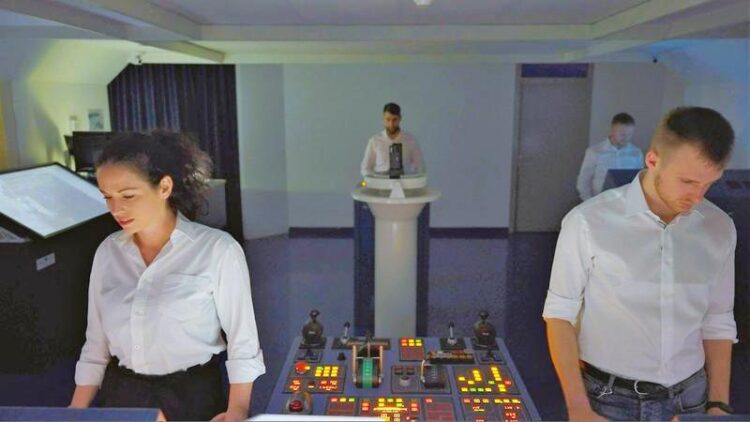Greater safety through better communication at sea

An automatic voice monitoring system for the ship’s bridge will ensure greater safety
(c) ELNAV
Automatic voice monitoring for the ship’s bridge.
Many accidents at sea are due to errors in communication between seafarers. An automatic voice monitoring system for the ship’s bridge will ensure greater safety. With the speech recognition system and support from Fraunhofer IDMT in Oldenburg, Germany, ELNAV, a start-up company based in Split, Croatia, is developing what it calls a “Helm Order Monitor”.
November 23, 2022. Communication in the maritime environment is important for safety but does not always run smoothly. This can have catastrophic consequences. After all, 90 percent of all accidents at sea are caused by human error, and half of these by problems with communication. In collaboration with Jade University of Applied Sciences (Elsfleth Campus) and partners from industry, Fraunhofer IDMT in Oldenburg, Germany, has been working for some time on improving safety-relevant voice communication, particularly at sea.
»In addition to developing chatbots for training purposes and recruitment procedures, the focus is on systems for monitoring voice commands on the ship’s bridge. For this purpose, we have trained our speech recogniser’s AI with special vocabulary, known as “Nautical Terms and Phrases” or “maritime English”«, says Jan Wellmann, Head of Automatic Speech Recognition at the Oldenburg Branch for Hearing, Speech and Audio Technology HSA of Fraunhofer IDMT.
ELNAV, a start-up company based in the Croatian port city of Split, is developing what it calls a “Helm Order Monitor”. This electronic device uses speech recognition technology from Fraunhofer IDMT in Oldenburg in conjunction with data received from the ship’s sensors and monitors whether the commands issued are clear, confirmed and correctly executed.
Hrvoje Mihovilović, ELNAV’s founder and CEO says: »In the beginning, the biggest obstacle for ELNAV was deciding whether to develop our own speech recognition system or find a partner. We needed a robust speech detector that would work reliably even under difficult acoustic conditions. We soon discovered that Fraunhofer IDMT was developing a speech recognition model for maritime communications and therefore an ideal partner for the development of our Helm Order Monitor.«
Technological challenges
The partners faced three main technological challenges. The first was the signal degradation caused when using far-field microphones in speech-processing applications. The noise level on the bridge should not interfere with verbal communication, mask audible alarms or be uncomfortable for bridge personnel: the ambient noise level on the bridge in calm weather should not exceed 65 dB(A). To solve this problem, microphone array signal processing is presented as an alternative.
The accuracy of Automatic Speech Recognition (ASR) under different noise conditions and at various distances was a further challenge. To make the ASR system more robust in noisy environments, deep neural networks (DNN) are used to enhance speech.
A third challenge was catering for the endless variations of the English language – from different regional accents to idiosyncratic use of grammar and vocabulary. Here, machine learning is used to create a single, comprehensive language pack which is accurate and encompasses as many variations of English as possible.
»The latest report on European Maritime Safety (EMSAFE) sees digitalization and increasing automation as a major opportunity. However, the technologies could also bring new challenges for safety as well as crew training. The changes required for this are supported by our speech recognition system. It can be used to learn, test and monitor maritime English in practice«, emphasizes Dr. Jens Appell, head of the Oldenburg branch of Fraunhofer IDMT.
Hearing, Speech and Audio Technology HSA at Fraunhofer IDMT in Oldenburg
Founded in 2008 by Professor Birger Kollmeier and Dr. Jens-E. Appell, the Oldenburg Branch for Hearing, Speech and Audio Technology HSA of the Fraunhofer Institute for Digital Media Technology IDMT stands for market-oriented research and development with a focus on the following areas:
• Speech and event recognition
• Sound quality and speech intelligibility
• Mobile neurotechnology and systems for networked healthcare
With in-house expertise in the development of hardware and software systems for audio system technology and signal enhancement, over 100 employees at the Oldenburg branch are responsible for transferring scientific findings into practical, customer-oriented solutions.
Through scientific cooperation, the institute is closely linked to the Carl von Ossietzky University of Oldenburg, Jade University of Applied Sciences, and Emden/Leer University of Applied Sciences. Fraunhofer IDMT is a partner in the »Hearing4all« cluster of excellence.
Further information on www.idmt.fraunhofer.de/hsa
Contact for the media:
Christian Colmer
Head of Marketing and Communication
Fraunhofer Institute for Digital Media Technology IDMT
Oldenburg Branch for Hearing, Speech and Audio Technology HSA
Marie-Curie-Str. 2
26129 Oldenburg
Tel.: +49 441 2172-436
christian.colmer@idmt.fraunhofer.de
http://www.idmt.fraunhofer.de/hsa
Weitere Informationen:
Media Contact
All latest news from the category: Communications Media
Engineering and research-driven innovations in the field of communications are addressed here, in addition to business developments in the field of media-wide communications.
innovations-report offers informative reports and articles related to interactive media, media management, digital television, E-business, online advertising and information and communications technologies.
Newest articles

A blueprint for mapping melting ice sheets
Researchers in the Stanford Radio Glaciology lab use radio waves to understand rapidly changing ice sheets and their contributions to global sea-level rise. This technique has revealed groundwater beneath Greenland,…

Water hyacinth plant pots – utilization of an invasive species
Together with Fiber Engineering GmbH, the DITF presents a process for the production of biodegradable plant pots. The products are cost effective and competitive. At the same time, the production…

Current research on the new 6G mobile communications standard
Nursing care robots, autonomous driving, digital twins: all of these high-tech applications will play an essential role for the new 6G mobile communications standard. The first commercial 6G networks are…



